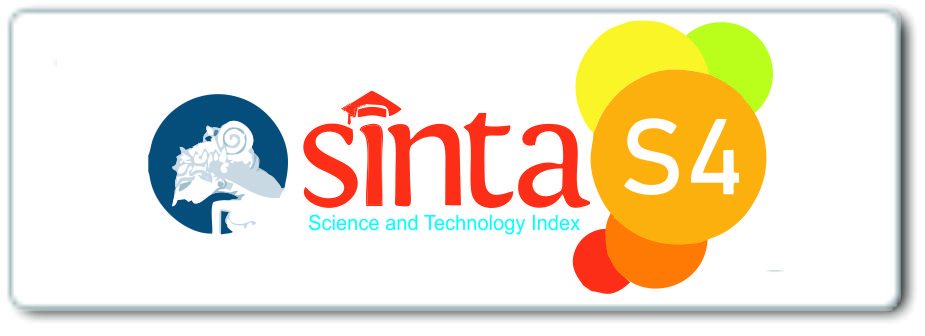The Correlation between Serum C3 and C4 Complement Levels with Disease Activity Systemic Lupus Eritematosus Patients In Dr. Soetomo Hospital, Surabaya
Downloads
Methods: This study used an observational analytic method with a cross-sectional design. The sampling technique was consecutive sampling. The samples of this study were SLE patients who were treated in the inpatient room and poly rheumatology in January-December 2018 periods. The data were analyzed statistically using the Pearson test.
Results: There were 150 SLE patients, most of whom were women (90.0%) with mean age of 29.01±9.8 years. Most levels of complement were low levels (C3 = 48.0% and C4 = 50.7%). Most disease activities were severe flares (44.7%). Results of the Pearson test complement C3 with disease activity were p =0.001, and level of correlation was r =-0.287. However, results of the Pearson test complement C4 with disease activity were p =0.026, and level of correlation was r =-0.182.
Conclusion: There is negative correlation between C3 and C4 complement levels with disease activity of SLE patients in Dr. Soetomo Hospital, Surabaya which is significant, weak and opposite.
Qu C, Zhang J, Zhang X, Du J, Su B, and Li H. Value of combined detection of anti nuclear antibody, anti double stranded DNA antibody and C3, C4 complements in the clinical diagnosis of systemic lupus erythematosus. Exp Ther Med. 2018;1390–4.
The Lupus Foundation of America. Understanding Lupus. 2013 [cited 2019 May 20]. Available from: https://www.lupus.org/understanding-lupus
Judha M, and Setiawan DI. Apa dan Bagaimana Penyakit Lupus? (Sistemik Lupus Eritematosus). Gosyen Publishing. 2015.
Kementrian Kesehatan. Infodatin situasi lupus di indonesia 2017. Pusat Data dan Informasi Kementrian Kesehatan RI. 2017.
Gandino IJ, Scolnik M, Bertiller E, Scaglioni V, Catoggio LJ, and Soriano ER. Complement levels and risk of organ involvement in patients with systemic lupus erythematosus. Lupus Sci Med. 2017;4(1):1–5.
Hikmah Z, and Prihaningtyas RA. Bersahabat dengan lupus: kupas tuntas SLE pada anak. Jakarta: PT Gramedia. 2018.
Feld J, and Isenberg D. Why and how should we measure disease activity and damage in lupus? Press Medicale. 2014;43(6P2).
Mikdashi J, and Nived O. Measuring disease activity in adults with systemic lupus erythematosus: The challenges of administrative burden and responsiveness to patient concerns in clinical research. Arthritis Res Ther. 2015;17(1):1–10.
Mosca M, Merrill JT, and Bombardieri S. Assessment of Disease Activity in Systemic Lupus Erythematosus. First Edit. Systemic Lupus Erythematosus: A Companion to Rheumatology. Elsevier Inc. 2007. 19–23p.
Hospital for Special Surgery. Understanding Lupus Lab Tests and Results for Lupus (SLE). 2015 [cited 2019 May 24]. Available from: https://www.hss.edu/conditions_understanding-laboratory-tests-and-results-for-systemic-lupus-erythematosus.asp.
Tseng M-H, Lin S-H, Wu C-Y, Chien H-P, Yang H-Y, Chen Y-C, et al. Serum complement factor I is associated with disease activity of systemic lupus erythematosus. Oncotarget. 2018;9(9):8502–11.
Yuan Y, Zhao L, Ye Z, Ma H, Wang X, and Jiang Z. Association of toll"‘like receptor 9 expression with prognosis of systemic lupus erythematosus. Exp Ther Med. 2019;3247–54.
Weckerle CE, and Niewold TB. The unexplained female predominance of systemic lupus erythematosus: Clues from genetic and cytokine studies. Clin Rev Allergy Immunol. 2011;40(1):42–9.
Mohamed AAA, Hammam N, EL Zohri MH, and Gheita TA. Cardiac Manifestations in Systemic Lupus Erythematosus: Clinical Correlates of Subclinical Echocardiographic Features. Biomed Res Int. 2019;2019:1–8.
Sutcliffe N, Clarke A, evinton C, Frost C, Gordon C, and Isenberg D. Associates of health status in patients with systemic lupus erythematosus. J Rheumatol. 1999;2352–6.
Chaiamnuay S, Lomaratana V, Sumransurp S, Phukongchai S, Narongroeknawin P, and Asavatanabodee P. Health related quality of life and disease severity of SLE patients in Phramongkutklao Hospital. J Med Assoc Thai. 2010;S125–30.
Marc D, and Olson K. Hypersensitivity Reactions and Methods of Detection. Neurosci Inc. 2009;1–4.
Maidhof W, and Hilas O. Lupus: an overview of the disease and management options. PT. 2012;37(4):240–9.
Fanouriakis A, and Bertsias G. Changing paradigms in the treatment of systemic lupus erythematosus. Lupus Sci Med. 2019;6(1):1–10.
Bertsias G, Cervera R, and T Boumpas D. Systemic Lupus Erythematosus: Pathogenesis and Clinical Features. EULAR Textb Rheum Dis. 2015;(1909):476–505.
Adwan M. Clinical and Serologic Characteristics of Systemic Lupus Erythematosus in the Arab World: A Pooled Analysis of 3,273 Patients. Arch Rheumatol. 2019;33(4):455–63.
Kim AHJ, Strand V, Sen DP, Fu Q, Mathis NL, Schmidt MJ, et al. Association of Blood Concentrations of Complement Split Product iC3b and Serum C3 With Systemic Lupus Erythematosus Disease Activity. Arthritis Rheumatol. 2019;71(3):420–30.
Narayanan K, Marwaha V, Shanmuganandan CK, and Shankar S. Correlation between systemic lupus erythematosus disease activity index, C3, C4 and anti-dsDNA antibodies. Med J Armed Forces India. 2010;66(2):102–7.
Senaldi G, Makinde VA, Vergani D, and Isenberg DA. Correlation of the activation of the fourth component of complement (C4) with disease activity in systemic lupus erythematosus. Ann Rheum Dis. 1988;47(11):913–7.
Sandhu V, and Quan M. SLE and Serum Complement: Causative, Concomitant or Coincidental?. Open Rheumatol J. 2017;11:113–22.
Copyright (c) Author
1. The journal allows the author to hold the copyright of the article without restrictions.
2. The journal allows the author(s) to retain publishing rights without restrictions.
3. The formal legal aspect of journal publication accessibility refers to Creative Commons Atribution-Share Alike 4.0 (CC BY-SA).






















